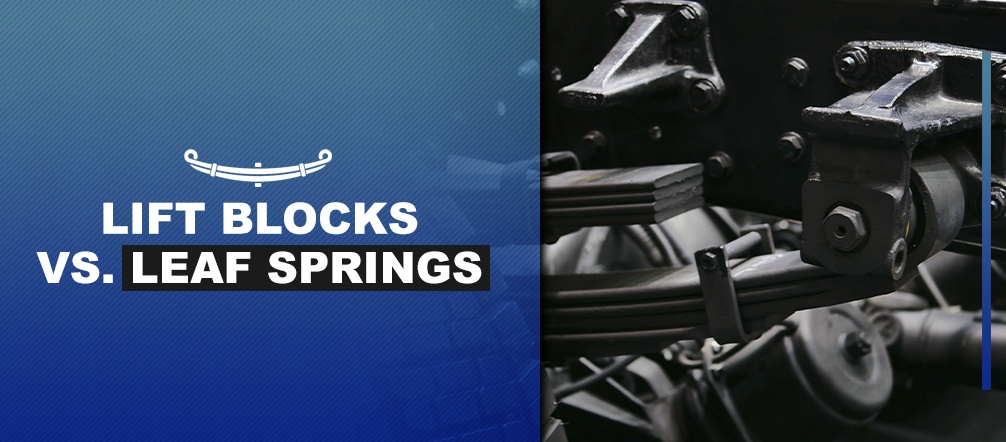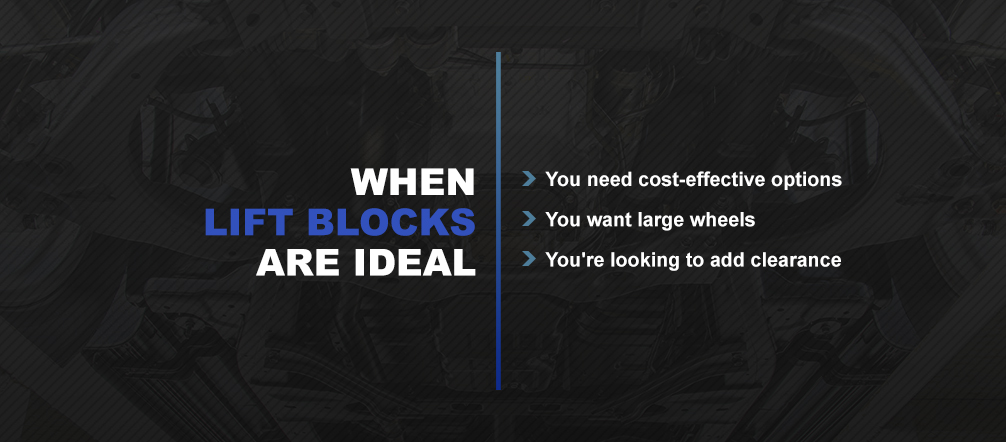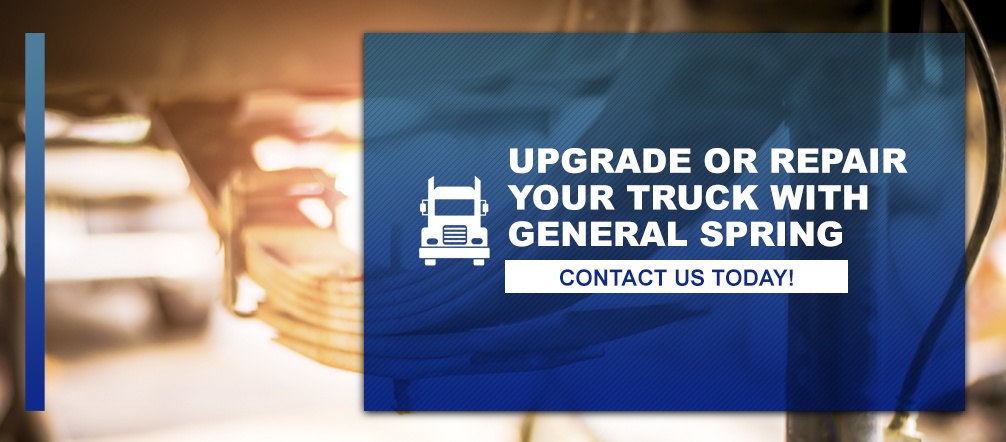Dec 6th 2020
Lift Blocks vs. Leaf Springs
Lift Blocks vs. Leaf Springs
When you want to raise your truck or improve your vehicle's suspension, you're likely going to see lift blocks and leaf springs in your search. These parts can be used together to raise the height of your truck and improve its carrying capacity. There may be times when you only want one of them, so it's important you know the difference between the two.
Learning about the times when either option is going to be ideal will help you make a wise decision the next time you upgrade your truck. Besides learning how they differ, you should be aware of what goes into installing them.
What Are Lift Blocks?
Lift blocks raise a vehicle's back end. As you might expect from their name, they're a block that adds extra space between the leaf spring and the axle. Drivers use lift blocks to raise the backs of their vehicle either for cosmetic reasons or to provide some practical benefits like making more space for larger wheels or adding extra clearance space.
What Are Leaf Springs?
Leaf springs are a type of suspension system. People have used some version of them since the medieval era. They're an arc-shaped piece of steel that's installed on the rear of a truck to increase the weight-carrying capacity. They help prevent a vehicle's axle from snapping due to more weight being placed on it than the vehicle was originally designed to handle. They also assist with making a ride smoother and adding extra support.
When to Use Lift Blocks and When to Use Leaf Springs
Sometimes lift blocks and leaf springs are great additions to a vehicle. If you're wondering whether you should add either option to your vehicles, you should know the pros and cons of using lift blocks or springs.

When Lift Blocks Are Ideal
Lift blocks increase the amount of space between your spring pack and axle. As such, they come with unique benefits that make them ideal for some truck owners. Check out some of the situations where lift blocks are a great choice:
- You need cost-effective options. Lift blocks are a very affordable option when you want to increase the height of your truck. They're usually very cost-effective compared to other heightening options.
- You want large wheels. If you want to trick out your truck with larger wheels, you sometimes need to raise the truck's height to make room. A lift block can help you accomplish this purpose and get the tires you want on your truck.
- You're looking to add clearance. If you're going to take your truck off the beaten path or on some uneven roads, you'll likely need to add some extra clearance. You don't want the rear of your truck smacking down on the ground, and lift blocks help to prevent this from happening by raising the back of your truck.
Using lift blocks comes with many advantages, but there are still times when they're not ideal. For instance, you should never use lift blocks for a front axle application. Steering will place side loads on the lift blocks, which can create major safety concerns. If the U-bolts loosen or the block breaks, you may lose control over the vehicle's steering.
Additionally, for trucks with lift blocks installed in them at the factory, you shouldn't stack extra lift blocks onto them. Extra lift blocks can end up falling out or folding, damaging your vehicle and causing potentially costly repairs.
When Leaf Springs Are Ideal
Leaf springs come standard in many trucks. Even if you already have one in your vehicle, you may want to upgrade your leaf spring or replace an older one. To know if you should upgrade, consider some of the advantages customers regularly highlight as the reason for adding new leaf springs:
- Increase carrying capacity: One of the primary advantages of leaf springs is their ability to increase the carrying capacity of a vehicle. Since they attach to the chassis and rear axle, they can help support the additional weight. The extra carrying capacity means you can use your truck to transport heavier materials safely.
- Keep tires aligned: Leaf springs help keep a vehicle's tires aligned by controlling the vehicle's height and locating the axle. This greater alignment leads to better handling and protects your tires. Uneven alignment regularly leads to uneven tire wear, so leaf springs are an excellent option if you're looking to keep your vehicle aligned.
- Get a smoother ride: If you're riding on bumpy roads, leaf springs can stabilize your vehicle when going over rough terrain. The extra lift leaf springs provide gives drivers a much smoother driving experience over gravel roads or bumps.
How to Install Lift Blocks
While the installation process may differ slightly based on the type of lift block, some general steps apply to the installation of most lift blocks. If you're wondering how to install lift blocks, you can take a look at the overview of the installation process below:
- Inspect your lift block kit: In your lift block kit, you should have the U-bolts, nuts and, of course, the lift blocks. Ensure that all of the parts you've purchased are there, while also checking to see the proper lift block for your vehicle.
- Chock your front wheels: You don't want your vehicle moving while you install your lift blocks. Since you'll be removing your rear wheels from the truck, you need to chock the front wheels so the vehicle doesn't move when you lift the rear.
- Lift vehicle and remove rear wheels: After securing the front wheels, you can then raise your vehicle off the ground and remove the rear wheels to access the area where you're going to place your lift blocks. Use a jack stand to keep the truck steady while you install the lift blocks.
- Unbolt and lower rear axle: The next step of the process is removing the nuts and U-bolts of the rear axle. Next, you lower your rear axle until you have space between your axle and the leaf spring.
- Install lift blocks: After you've made enough space for your lift block to fit, center your lift block using the two holes on the axle's top plate.
- Complete installation: With your blocks now centered and in the proper position, you'll lift your axle again. You'll bolt your lift block, axle and spring back, tightening the bolts to the manufacturer's specs. Finally, reinstall your wheels and lower the vehicle to the ground.
How to Install Leaf Springs
To understand how to install leaf springs, check out our in-depth guide to replacing leaf springs. Here's an overview of the process:
- Prepare vehicle: Before you remove the old leaf springs, take a few days to get the suspension system ready. Part of this process includes loosening the suspension system with oil.
- Raise the vehicle: To get to the leaf springs, you should place a jack stand under the rear axle, suspending the truck's rear off of the ground. You'll also need to remove the rear wheels to have clear access to the leaf springs.
- Remove base plate: The next step is removing the leaf springs. This process revolves around removing fasteners, plates and bolts to get to the old leaf spring and remove it.
- Install the new leaf spring: After you've removed the old spring, you'll install the new one. Make sure you align the leaf spring properly and then secure it appropriately.
- Complete installation: Once you've secured the new leaf spring, you can replace the pieces you previously removed. Once everything is installed, you can put the wheels back on and lower your vehicle to the ground.
Upgrade or Repair Your Truck With General Spring

Next time you're looking to repair or upgrade your truck, turn to General Spring. We've been the automotive suspension and leaf spring authority since 1965. Now that you know more about leaf springs and lift blocks, you can decide whether either option is right for you. We're proud to offer a huge inventory of leaf springs and can even custom-make leaf springs for customers who own a vehicle where springs aren't as readily available.
Browse our selection of leaf springs today. If you have any questions about our products or how to install lift blocks and leaf springs, please feel free to contact us.
